

2.0.1
SGC Tri-Coordinates |
|||||
|---|---|---|---|---|---|
| Source | Data In | Data Out | |||
| known | Apparent Stellar Distance to the star (ASD) | ||||
| known | Earth Polar Right Ascension of the star (RA) | Galactic Right Ascension (Gr) | |||
| known | Earth Polar declination of the star (d) | Galactic declination (Gd) | |||
| known | Earth polar declination of the galactic north ( ) ) |
||||
| known | Earth polar Right Ascension of the North Galactic Pole.
( ) )
Earth polar angle to the galactic center (  ) ) |
 ) ) to (  ) Drop Point of Star (DDP). ) Drop Point of Star (DDP).
|
|||
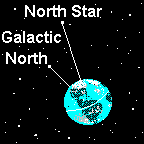
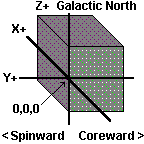
2.2.1

Where angle b is a variable and may be positive
or negative, Gd = galactic declination of the star (from
0° to 180°),  = the Earth polar declination
of the north galactic pole, RA = Earth polar Right Ascension of
the star, d = Earth polar declination of the star, and
= the Earth polar declination
of the north galactic pole, RA = Earth polar Right Ascension of
the star, d = Earth polar declination of the star, and  = Earth polar Right Ascension of the north galactic pole.
= Earth polar Right Ascension of the north galactic pole.
To determine galactic Right Ascension either of the
following applies:
2.2.2

Where  = the angle from Earth polar to
the galactic center. (In the SGC system, the direction to the galactic
center would be Y negative.) Gr = The galactic Right
Ascension of the star.
= the angle from Earth polar to
the galactic center. (In the SGC system, the direction to the galactic
center would be Y negative.) Gr = The galactic Right
Ascension of the star.
The SGC system creates four possible quadrants
of X and Y. Using the angle to galactic center, Y
negative, as the 0° mark and moving in a counter clockwise direction
as seen from above, matching the Right Ascension. The following applies:
2.3.1
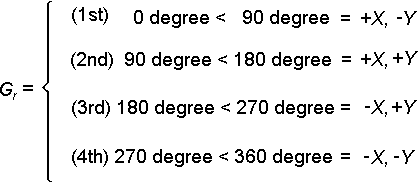
Further division can be made of these four quadrants into eight sectors where four sectors have positive Z values above or north of the line from our Sun to the galactic center and four sectors below or south of this line. I have arbitrarily named the galactic sectors using the Greek alphabet; alpha, beta, gamma, delta, kappa, sigma, tau and omega.
Where the sectors are named from above in a counter-clockwise
rotation:
2.3.2
| The Galactic Sectors | |
|---|---|
| Alpha
X+, Y+, Z+ |
Beta
X+, Y-, Z+ |
| Gamma
X-, Y+, Z+ |
Delta
X-, Y-, Z+ |
- - - The Galactic Equator- - - |
|
| Kappa
X+, Y+, Z- |
Sigma
X+, Y-, Z- |
| Omega
X-, Y+, Z- |
Tau
X-, Y-, Z- |
Illustration 2.3.3
Transferring galactic Right Ascension, galactic declination,
and distance to the star to X, Y, and Z coordinates
becomes an exercise in trigonometry.
Graph 2.3.4
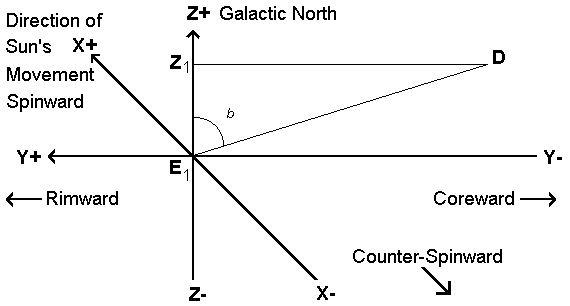
Graph 2.3.4 shows a Z coordinate value for a star at D. The X, Y, and Z axis are set, as previously stated, to the SGC system; where X + = Spinward, the direction of the Sun's galactic orbit, X - = Counter-Spinward, Y + = Rimward, towards the outer rim of our galaxy, Y - = Coreward, to the center of the galaxy, Z + equals galactic North Pole and finally, Z - = the galactic South Pole. Angle b shows the galactic declination of star D. E1Z1 = the Z coordinate value of star at D.
It can be seen that if angle b and the
distance from E1D is known, it becomes a simple matter
to find E1Z1. This value is the the star
D'
SGC Z coordinate value.
2.3.5

One more value is needed to find before resolving a
three coordinate solution. The value needed is the distance from the 0,0,0
coordinate to the drop point of the star to the XY plane. This distance
is designated as Distance to Drop Point (DDP). This distance is
obviously smaller than the Apparent Stellar Distance (ASD) because
the ASD is the hypotenuse and the DDP is an adjacent side.
Graph 2.3.6
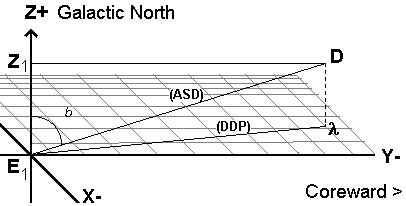
(The galactic center is considered the starting point of the galactic Right Ascension and thereby makes any X values positive when the galactic Right Ascension is between 0° and 180°.The X values are negative when the galactic Right Ascension is between 180 degrees and 360 degrees.)The formula to find DDP is:
2.3.7
Therefore to transfer galactic based values of Right
Ascension and declination to the SGC X coordinate:
2.3.8
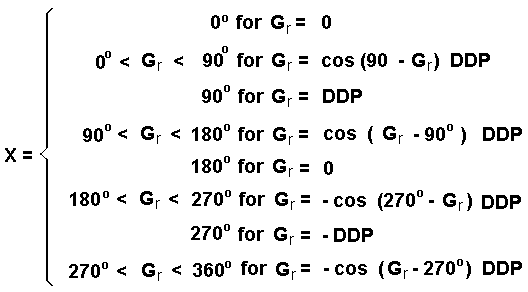
Transfer to the SGC - Y coordinate can be derived
in a similar fashion:
2.3.9
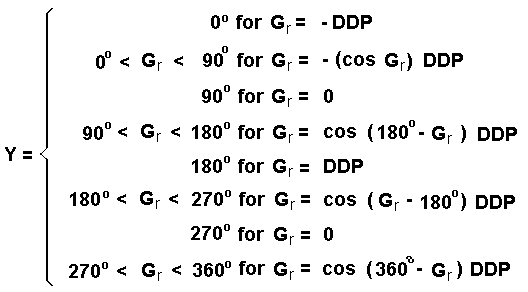
To transfer galactic based values to the SGC -
Z coordinate, you must use the Apparent Steller Distance (ASD)
and not the DDP:
2.3.10
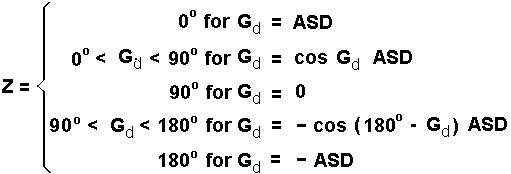
It must be remembered that galactic declination may take the values from 0° to 180° and galactic Right Ascension may take values from 0° to less than 360°.
This defines the trigometric solution to finding the X,
Y
and Z coordinates based on the galactic Right Ascension, galactic
declination and Apparent Stellar Distance.
Return to Table of Contents | The Appendix Last updated: October 3, 2002 |